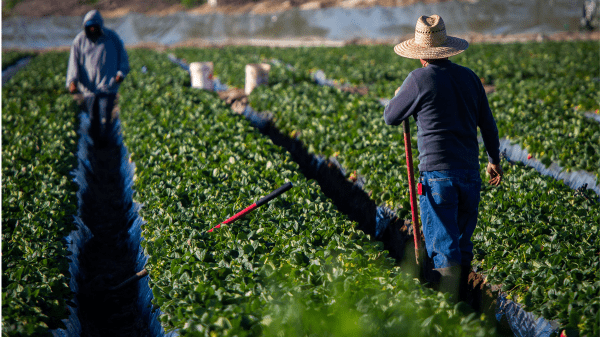The murderous summer has drawn new attention to heat safety for farmworkers.
“Occupational heat-related mortality is 35 times higher among agricultural workers compared to workers from other industries,” according to a 2022 study from the National Institutes of Health.

Currently there is no federal standard for agricultural heat safety regulations, and given the almost invisible speed at which OSHA moves, there’s not likely to be one soon.
Some states, notably California, do have such provisions. “California is one of a few states with laws that mandate employers provide water breaks, shade and rest for outdoor workers once temperatures reach certain levels,” notes CalMatters, a California-related news source.
The problem is heightened by the fact that many workers are paid on a piece-rate basis, so that the fewer items picked, the less the worker gets paid. Hence workers may force themselves to push on despite the risk of heat stroke.
Sometimes the pressure comes from the employer. “I’ve had bosses who, if they see you resting for a few minutes under a tree to recover yourself, think you’re wasting your time and send you home without pay,” said one worker.
Rather than going into legislative and regulatory ins and outs, I think the most useful thing I can do here is to quote Environmental Protection Agency guidelines for worker safety in extreme heat:
“Training. Train workers and supervisors on how to control heat stress and to recognize symptoms of heat illness.
“Monitoring and Adjusting Workloads. Take into account the weather, workload, and condition of the workers, and adjust work practices accordingly. Higher temperatures, high humidity, direct sun, heavy workloads, older workers, and workers unaccustomed to heat are more likely to become ill from heat.
Here are things to do:
“• Monitor temperature and humidity, and workers’ responses at least hourly in hot environments.
“• Schedule heavy work and tasks requiring personal protective equipment (PPE) for the cooler hours of the day.
“• Acclimatize workers gradually to hot temperatures.
“• Shorten the length of work periods and increase the length of rest periods.
“• Give workers shade or cooling during breaks.
• “Halt work altogether under extreme conditions.
“Drinking. Make sure employees drink at least the minimum required amounts of water to replace body fluid lost through sweating. Thirst does not give a good indication of how much water a person needs to drink.”
Labor Day serves as a kind of end to the summer, and here in the northern latitudes of the United States, heat tends to diminish fairly soon afterward. But not always, and certainly not in more southerly parts of the nation. There are, unfortunately, still many occasions for heat stroke risk this season.



